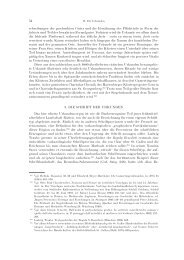Chapter Three ANTHOLOGIES AND ANTHOLOGISTS Between c ...
Chapter Three ANTHOLOGIES AND ANTHOLOGISTS Between c ...
Chapter Three ANTHOLOGIES AND ANTHOLOGISTS Between c ...
Create successful ePaper yourself
Turn your PDF publications into a flip-book with our unique Google optimized e-Paper software.
104<br />
Part One: Texts and Contexts<br />
ful Runaway Love are particularly interesting because the poem was included in<br />
the Garland of Meleager. This strongly suggests that Constantine the Sicilian<br />
was familiar with the contents of the Garland already at a young age, which<br />
may serve as an argument in favour of an early date for the compilation of<br />
PCP: say, in the late 840s or the 850s.<br />
Erotic epigrams and anacreontics seem to have been popular in the circle of<br />
Leo the Philosopher. Theophanes the Grammarian is the author of an anacreontic<br />
entitled in the index of Barb. gr. 310: “how he loves his friend and how<br />
he is not loved in return because of his extreme affection” 64 . Unfortunately, the<br />
anacreontic is not preserved in the manuscript, so we can only guess how<br />
Theophanes may have treated this daring theme without getting himself into<br />
trouble. Theophanes also wrote the following erotic epigram: “If only I could<br />
be a white lily so that you may put me close to your nostrils and satiate me still<br />
more with your skin” (AP XV, 35). The epigram is an obvious imitation of<br />
AP V, 83 and 84, the second of which reads in translation: “If only I could be<br />
a pink rose so that you may take me in your hand and put me between your<br />
snowy breasts” 65 . In the Palatine manuscript Theophanes’ epigram can be<br />
found near the end, but originally, in the anthology of Cephalas, it immediately<br />
followed AP V, 83–84 66 . The beginning of AP V (nos. 2–103) contains a great<br />
number of epigrams deriving from the so-called Sylloge Rufiniana. This was a<br />
small sylloge of erotic epigrams by the first-century poet Rufinus; since the<br />
sylloge also contained a few “Diogenianian” authors, such as Gaetulicus, Cillactor<br />
and Nicarchus, it was probably compiled by the second-century anthologist<br />
Diogenian 67 . It is impossible to reconstruct the original Sylloge Rufiniana,<br />
but we can identify in AP V at least three sequences of epigrams deriving from<br />
it (with additional material from other sources): AP V, 14–22, 27–51 and 66–84.<br />
Theophanes’ epigram and the two epigrams that he imitated are found at the<br />
end of the last sequence. What exactly has Theophanes to do with the Sylloge<br />
Rufiniana? Not an easy question, but we should bear in mind the overall design<br />
of Cephalas’ anthology. His anthology is basically a collection of Hellenistic,<br />
early Roman and late antique epigrams. That is why AP V–VII and IX–XIV<br />
do not contain contemporary poetry, with the tantalizing exception of a few<br />
64 See the index in GALLAVOTTI 1987: no. 64.<br />
65 For the text of these three epigrams, see CAMERON 1993: 283–285. Cameron supposes that<br />
AP V, 84 is also the work of Theophanes, but attaches too much importance to an<br />
incorrect reading in Arethas. He does not pay attention to the vocabulary. In AP XV,<br />
35 Theophanes uses two Byzantine neologisms, croti8 (see ThGL) and ärg6nnaoß; AP V,<br />
84, on the contrary, is written in Hellenistic Greek.<br />
66 See CAMERON 1993: 283–285.<br />
67 See P. SAKOLOWSKI, De Anthologia Palatina quaestiones. Leipzig 1893, 64–71, and<br />
CAMERON 1993: 84–90.




